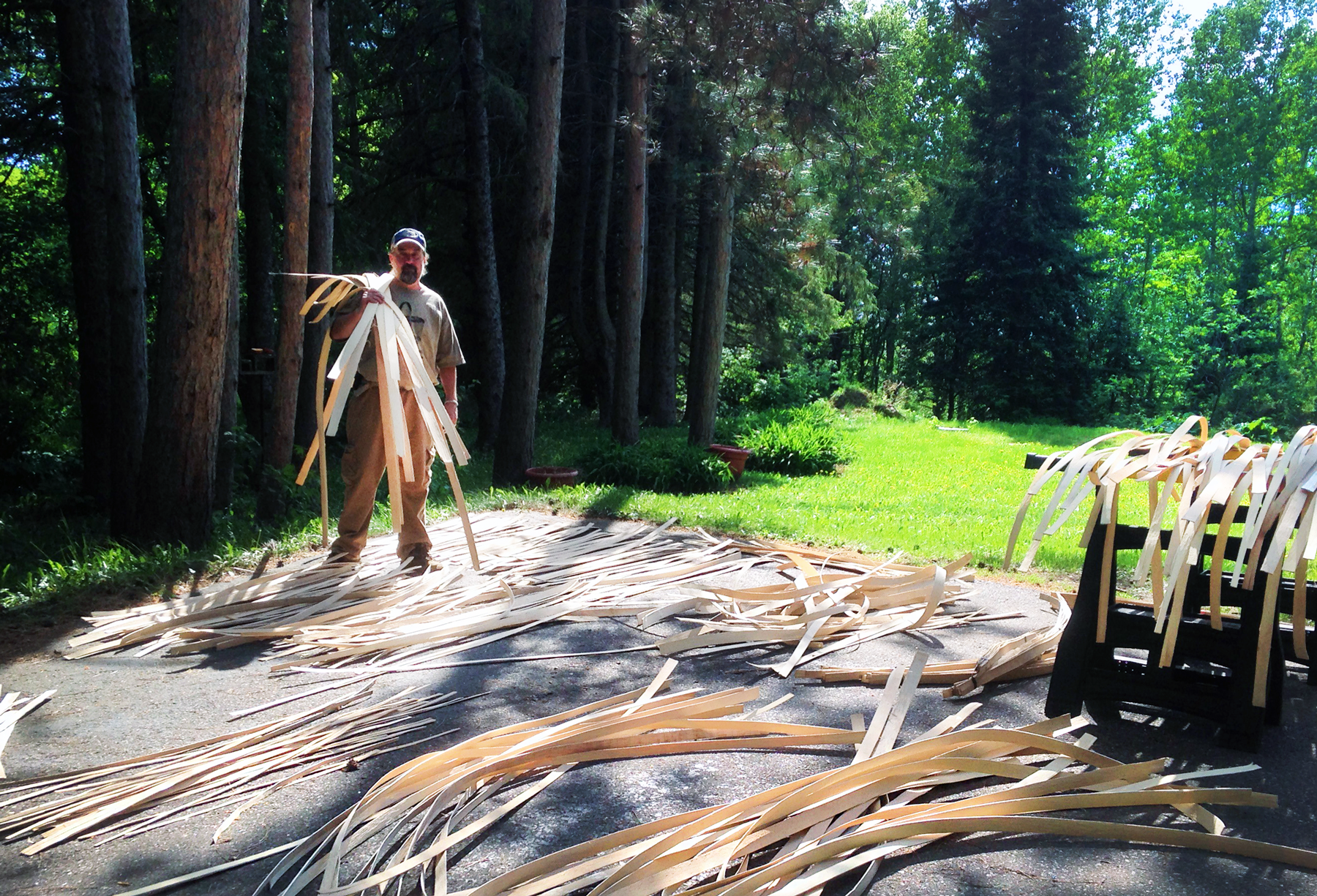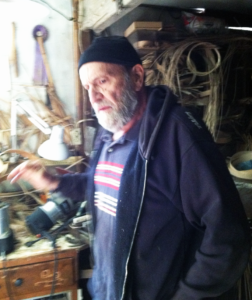
Eric often gets questions about where he is getting his black ash materials. Most of his students who take his workshops know that it can be hard to find and now, with the devastating Emerald Ash Bore, it is becoming even more difficult. While Eric is currently processing probably the last five years or so of black ash materials, I thought I’d give some insight into all the work “behind the scenes” in finding, retrieving and processing materials.
Growing up in New England, the Black Ash tree is also known as the “Basket Tree.” I have learned this from Eric AND from the illustrated book Basket Moon, by Mary Lyn Ray that I often read to my nephew every Monday afternoon when we FaceTime each other. Black Ash is the best for baskets because of its strength and flexibility. (I have a link to the book below if anyone is interested – it’s a cute story about a young boy who discovers he wants to be a bushwhacker basketmaker like is Pa.)
Several decades ago, Eric said in northern New Hampshire you had to to hunt for the Black Ash tree, but you could find them. Primarily, they grow on the edges of swamps—loving the shade and cooler climate of the wetlands. And back then, nobody knew about the insect from Asia that would come to America and start killing off the more prevalent relative to the Black Ash tree, the White Ash tree.
Five years ago, we moved to middle Tennessee where the “Basket Tree” does not grow. So, how and where did Eric get his materials? He still had sources in New England that would track the tree down and who also had the equipment to pound and pull the strips off and send the raw material to Eric in Tennessee. Then there was the great splint maker Bob Coker. Bob was known for processing the finest quality black ash from the beginning to end. Eric met Bob over twenty years ago and when he sold his business shortly thereafter, he thankfully continued making any splint that Eric needed. Since the move and setting up a new workshop and home took up considerable time for Eric who also still needed to make the molds, bases, handles and rims, Bob’s service was a life saver. Eric would call him every other month and put in an order to his specs. And many times, it would show up in the nick of time for Eric to leave for another workshop—and I’m talking about like that evening before an early morning departure.
By the way, who is Bob Coker? Well, from what I hear he’s a most interesting fellow—and an old-school craftsman and artisan. Inset is a quick pic of Bob moving about in his workshop. Eric snapped this on his phone while visiting him on his way home from the Michigan Basket Makers Convention this past October.
Despite Eric becoming more reliant on Bob, he knew that shortly, not only were the Emerald Ash Bore depleting Bob’s raw materials, he would also be retiring. Bob lived in the woods of Michigan where the Ash Bore first made it’s landing in a shipping container sitting at a port in Detroit.
Over the past five years, it inevitably became obvious that the end was near. Finally, Bob told Eric when his ash supply runs out he will be retiring. That was six months ago. Eric still talks to Bob who reiterates that there is no more Black Ash around. That’s hard for Eric to hear since he knows how dedicated Bob was in producing these materials. I also know Eric is eternally grateful to Bob and his craftsmanship.
So the last couple years Eric has been working on a plan.
In the next post I will update you on “Part 2” so to speak, on the Hunt for the Last Black Ash Tree. The “hunt” is real and time really is running out.
____
Click on the image to purchase the book from Amazon.


A very good and interesting post. Looking forward to part 2.
Believe it or not, I still have some of Bob’s black ash that I purchased years ago.
Well covet that black ash!!!
Thanks for posting the article, I have one black ash basket that I made with Bob Coker and several that I made with Eric ,all at the Stowe Baskety festival. Enjoyed spending several evenings with Eric at the Red Fox. Love your Blog.
Thank you for reading, thanks for the comment and thanks for the compliment!
A great post Lynne. Is the picture of Eric at the harvest site? You ended with a good cliffhanger. Finish soon. Thanks.
Yes Royce, that is Mr. Basketmaker!
Yes, I love working with ash. It’s my favorite. But I really did not know how precious it is/was until your posting here. This is a scary prospect. Even here in AZ, we are loosing all our pine trees due to parasites brought in from Asia. But now, for you, so much is based on that beautiful black ash and it’s very sad to think it could change so drastically. I want to see what you say in Part 2. Maybe a glimmer of hope? Much love,
Donna
It is all sad. Especially for all the craftspeople who rely on Black Ash for their livelihood.
Lynn-
I love reading your posts! Bob Coker is an amazing man. Thanks for educating other basketmakers about him and his great black ash splint. I also realize that the black ash is getting harder to find. I await your next post.
Why thank you Miss JoAnn. I realize you are in the same boat as Eric and only desire using the finest materials for your master baskets.
Thanks Joann for your comment, maybe we can get you to send us a little something about your experiences with ash in your neck of the woods. We would gladly post it. (make sure you send pics!)
That’s a great idea!
great post.
Thanks so much Karen!!
I am a Shaker Basket weaver. I am proud that I absolutely love weaving with Black Ash Joann calls me an Ash Snob so be it I love it and I am very upset about the future of ash. I watched the elm trees in Western New York get wiped out by the Elm Tree disease. Now they are worried about the grape vineyards and an Asian bug destroying them. I understand “global economy” but at what cost? I am anxious to see Eric’s Plan In North Carolina the hemlock are threatened and they are trying their hardest to same the hemlock. The kayakers that go into the woods on the creeks are even helping by treating the hemlock along the creeks to save it. My question: what can we do to save our Ash?
Thanks for the comment Linda. Eric is getting as much material as he can up north. He’s purchased several trees already and processed them. Unfortunately, I don’t think there’s any way to save the Ash. The bore infestation is too strong.